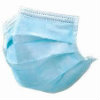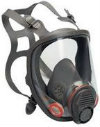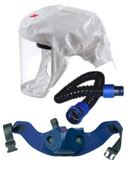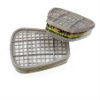Respiratory protection
The instances where there is need for the wearing of respiratory protective equipment (RPE) within a laboratory setting should be few as respiratory protection should only be considered necessary when engineering controls cannot be used effectively. Thus, work involving toxic gases, hazardous volatile substances and dusts, or any other respiratory hazard, should be kept away from persons by placing such work in a glove box, fume cupboard or other well ventilated zone.
When respiratory protection is chosen, it must be selected by relating the hazard to the respirator so that the expected protection to the wearer is fully realised. Half or full face respirators with replaceable canister type filters is the type recommended for use against such hazards and such a respirator, fitted with the appropriate filter(s), will protect against dusts, gases and vapours, but only against relatively low concentrations. Disposable masks with at minimum P3 protection factor can be used if a suitable fit is not achievable on a re-usable half mask or for certain specific tasks. Paper (spit) masks must not be used unless used for comfort only. The University has specific guidance for which masks should be used, detailed below.
It is a requirement of the Control of Substances Hazardous to Health (COSHH) Regulations that respiratory protective equipment is regularly inspected and tested, with appropriate record keeping and that users are adequately trained in the correct use and maintenance of such equipment. Also in compliance with the COSHH Regulations wearers of respirators that rely on a tight fit to the face to protect the worker are required to be individually face-fit tested to a particular make and size of respirator and a certificate of successful fit-test obtained, see: http://www.ed.ac.uk/schools-departments/health-safety/guidance/ppe/facefit
Self-contained breathing apparatus (BA) provides the best personal protection against toxic gases and hazardous volatile substances, but must never be used by untrained personnel. The School of Chemistry has a BA team trained for mobilisation in case of chemical spill, or gas escape, but only within that School. Some other Schools have trained Spill Teams who are equipped with full-face respirators and can be mobilised to deal with chemical spills. All new staff/students must be inducted as to the system(s) operating in their particular School.







